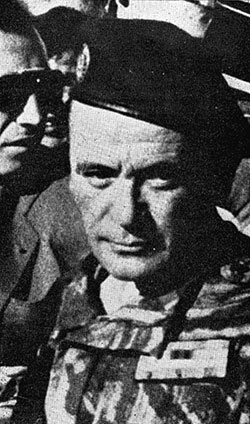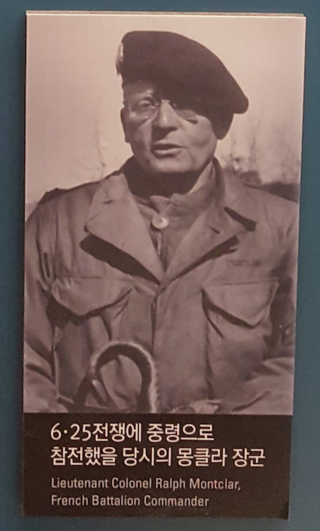Career
Pire was born in Hannut, Liège Province, Belgium on 29 March 1878. He enlisted in the Belgian Army in 1897, initially as a non-commissioned officer and subsequently as an officer. He was admitted to the Ecole de Guerre and served in the staff of the 3rd Brigade during the German invasion of Belgium in World War I. Transferring to the infantry, Pire rose rapidly through the ranks during the war and in its aftermath. The culmination of his career was as commander of the newly created Corps of Chasseurs Ardennais from 1936 to 1939. He retired in April 1939 as a lieutenant general, before being recalled in September when the outbreak of World War II led to the mobilisation of the Belgian Army, despite its neutral status. During the 18 Days' Campaign, Pire commanded the 10th Division of Chasseurs Ardennais.
With Belgium under German Occupation, Pire became involved in the resistance. In 1941, he was involved in the creation of the Belgian Legion, a group in the Belgian Resistance with right-wing political sympathies. He became the group's commander in Wallonia. The Belgian Legion subsequently merged with other groups, eventually becoming the Secret Army in 1944.
Following the arrest of Jules Bastin and his successor's escape to the United Kingdom, Pire became head of the Secret Army in January 1944. In this role, he led the group's mobilisation after the Normandy Landings and during the Liberation of Belgium from June to September 1944. He subsequently supervised the group's demobilisation before retiring. He died on 29 January 1953.

Chasseur, a French term for "hunter", is the designation given to certain regiments of French and Belgian light infantry or light cavalry to denote troops trained for rapid action.

Zygmunt Henryk Berling was a Polish general and politician. He fought for the independence of Poland in the early 20th century. Berling was a co-founder and commander of the First Polish Army, which fought on the Eastern Front of World War II.

The Belgian Resistance collectively refers to the resistance movements opposed to the German occupation of Belgium during World War II. Within Belgium, resistance was fragmented between many separate organizations, divided by region and political stances. The resistance included both men and women from both Walloon and Flemish parts of the country. Aside from sabotage of military infrastructure in the country and assassinations of collaborators, these groups also published large numbers of underground newspapers, gathered intelligence and maintained various escape networks that helped Allied airmen trapped behind enemy lines escape from German-occupied Europe.

The Vinkt massacre was a war crime committed by German soldiers in the villages of Vinkt and Meighem in East Flanders on 26–28 May 1940 during the Battle of the Lys. Between 86 and 140 civilians were deliberately killed by Wehrmacht troops from the 377th Infantry Regiment of the 225th Infantry Division, supposedly in retaliation for the Belgian Army's resistance in the village.

Jacques Pâris de Bollardière was a French Army general, famous for his advocacy of non-violence during the 1960s.

The Allied leaders of World War II listed below comprise the important political and military figures who fought for or supported the Allies during World War II. Engaged in total war, they had to adapt to new types of modern warfare, on the military, psychological and economic fronts.

The Axis leaders of World War II were important political and military figures during World War II. The Axis was established with the signing of the Tripartite Pact in 1940 and pursued a strongly militarist and nationalist ideology; with a policy of anti-communism. During the early phase of the war, puppet governments were established in their occupied nations. When the war ended, many of them faced trial for war crimes. The chief leaders were Adolf Hitler of Nazi Germany, Benito Mussolini of Fascist Italy, and Hirohito of Imperial Japan. Unlike what happened with the Allies, there was never a joint meeting of the main Axis heads of government, although Mussolini and Hitler met on a regular basis.
The Czech and Slovak Legion, also known as the Czechoslovak Legion, was a military unit formed in the Second Polish Republic after Germany occupied Czechoslovakia in March 1939. The unit took symbolic part in the defence of Poland during the German invasion on 1 September 1939.

The Bataillon de Chasseurs Ardennais is an infantry formation in the Land Component of the Belgian Armed Forces. Originally formed in 1933 to ensure the defense of Belgium's Luxembourg Province including the natural region of the Ardennes and particularly noted for its role during the German invasion of 1940, the unit currently serves as a mechanized infantry formation and forms part of the Motorized Brigade.

Yves Godard was a French Army officer who fought in World War II, First Indochina War and Algerian War. A graduate of Saint-Cyr and Chasseur Alpin, he served as a ski instructor in Poland during 1939, but after World War II began he returned to France. He became a prisoner-of-war in 1940 and tried several times to escape, finally succeeding on his third attempt. He made his way to France and joined the French Resistance maquis in Savoy. From December 1944 to February 1946, he headed the 27ème bataillon de chasseurs alpins.
Jules A. G. Bastin was an officer in the Belgian army during World War I and a resistance fighter in World War II.
Jean Bréchignac was a French Army officer who fought in World War II, First Indochina War and Algerian War. He led the 2nd Battalion, 1st Parachute Chasseur Regiment in Indochina, most notable during the Battle of Dien Bien Phu, and the 9th Parachute Chasseur Regiment in Algeria. His career ended when he took part in the 1961 Algiers putsch against the French government. He was described as one of the most accomplished officers of his period by Jules Roy.

Raoul Charles Magrin-Vernerey, also known as Ralph Monclar was a French officer and 2nd Inspector of the Foreign Legion who fought in World War I, World War II within the ranks of the Free French Forces and led the French Battalion in the Korean War. He was also one of the first senior officers to respond to the Appeal of 18 June.

Wacław Lipiński (1896–1949) was a Polish historian, military officer and resistance fighter, lieutenant colonel in the Polish Army of the Second Polish Republic, recipient of Polish highest military decoration, the Order of Virtuti Militari.
René Jacques Adolphe Prioux was a French general who served in both world wars. A cavalry officer of great talent, Prioux rapidly rose through the officer ranks and commanded the Cavalry Corps of the First Army during the Battle of Belgium in May 1940. He was captured by the Germans and spent two years as a prisoner of war. Repatriated in 1942, Prioux came to be seen as a strong supporter of the Vichy regime and was consequently removed from a position of authority in the French Army by Charles de Gaulle, the leader of the Free French, after the landings in French north Africa by U.S. and British forces in November 1942.

The Secret Army was an organisation within the Belgian Resistance, active during the German occupation of Belgium during World War II. With more than 54,000 members, it was by far the largest resistance group active in the country.
The Groupes Franc Motorisé de Cavalerie or GFC was a type of autonomous unit of the French Army created during the Nazi Invasion. Taking inspiration for their name from the Corps Francs which had played an important role in the Phoney War, they were a very early attempt to create truly independent Combined Arms Combat Teams. Although little more than Company sized, they had organic Armored, Artillery, and Infantry elements all rolled into one small and highly mobile force. They were created somewhat out of desperation in response to the rapid German advance into France and operated as independent strike forces with great latitude of movement. Although they were found to be quite effective, their existence died with the Third Republic.
Harold René Charles Marie, comte d'Aspremont Lynden was a Belgian cabinet minister, politician of the PSC-CVP and Cavalry Lieutenant-Colonel. He is also notable as Belgium's last Minister of African Affairs (1960-1961), serving as such in Gaston Eyskens' third cabinet. He was one of the Belgian authorities involved in the kidnap and assassination of Congolese Prime Minister Patrice Lumumba.
The 225th Infantry Division was an infantry division of the German Heer during World War II.
Gérard Pierre Louis François Armand Lecointe was a French général de corps d'armée. He served in World War II and the Cold War and saw colonial service in French North Africa. He was the last commander of French forces in Algeria, and completed his career as commander-in-chief of the French Forces in Germany.










